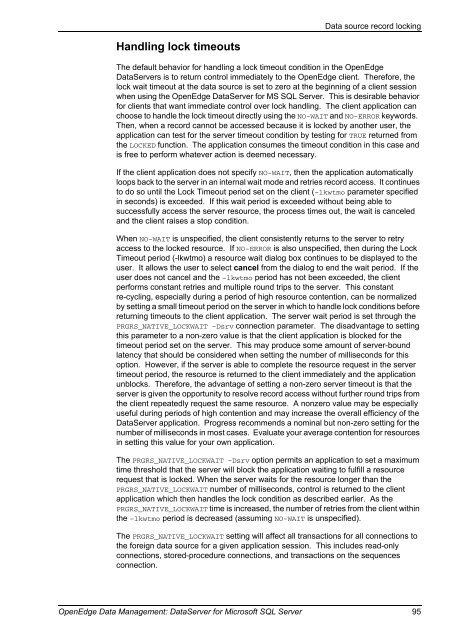OpenEdge Data Management: DataServer for Microsoft SQL Server
OpenEdge Data Management: DataServer for Microsoft SQL Server
OpenEdge Data Management: DataServer for Microsoft SQL Server
Create successful ePaper yourself
Turn your PDF publications into a flip-book with our unique Google optimized e-Paper software.
Handling lock timeouts<br />
<strong>Data</strong> source record locking<br />
The default behavior <strong>for</strong> handling a lock timeout condition in the <strong>OpenEdge</strong><br />
<strong>Data</strong><strong>Server</strong>s is to return control immediately to the <strong>OpenEdge</strong> client. There<strong>for</strong>e, the<br />
lock wait timeout at the data source is set to zero at the beginning of a client session<br />
when using the <strong>OpenEdge</strong> <strong>Data</strong><strong>Server</strong> <strong>for</strong> MS <strong>SQL</strong> <strong>Server</strong>. This is desirable behavior<br />
<strong>for</strong> clients that want immediate control over lock handling. The client application can<br />
choose to handle the lock timeout directly using the NO-WAIT and NO-ERROR keywords.<br />
Then, when a record cannot be accessed because it is locked by another user, the<br />
application can test <strong>for</strong> the server timeout condition by testing <strong>for</strong> TRUE returned from<br />
the LOCKED function. The application consumes the timeout condition in this case and<br />
is free to per<strong>for</strong>m whatever action is deemed necessary.<br />
If the client application does not specify NO-WAIT, then the application automatically<br />
loops back to the server in an internal wait mode and retries record access. It continues<br />
to do so until the Lock Timeout period set on the client (–lkwtmo parameter specified<br />
in seconds) is exceeded. If this wait period is exceeded without being able to<br />
successfully access the server resource, the process times out, the wait is canceled<br />
and the client raises a stop condition.<br />
When NO-WAIT is unspecified, the client consistently returns to the server to retry<br />
access to the locked resource. If NO-ERROR is also unspecified, then during the Lock<br />
Timeout period (-lkwtmo) a resource wait dialog box continues to be displayed to the<br />
user. It allows the user to select cancel from the dialog to end the wait period. If the<br />
user does not cancel and the –lkwtmo period has not been exceeded, the client<br />
per<strong>for</strong>ms constant retries and multiple round trips to the server. This constant<br />
re-cycling, especially during a period of high resource contention, can be normalized<br />
by setting a small timeout period on the server in which to handle lock conditions be<strong>for</strong>e<br />
returning timeouts to the client application. The server wait period is set through the<br />
PRGRS_NATIVE_LOCKWAIT –Dsrv connection parameter. The disadvantage to setting<br />
this parameter to a non-zero value is that the client application is blocked <strong>for</strong> the<br />
timeout period set on the server. This may produce some amount of server-bound<br />
latency that should be considered when setting the number of milliseconds <strong>for</strong> this<br />
option. However, if the server is able to complete the resource request in the server<br />
timeout period, the resource is returned to the client immediately and the application<br />
unblocks. There<strong>for</strong>e, the advantage of setting a non-zero server timeout is that the<br />
server is given the opportunity to resolve record access without further round trips from<br />
the client repeatedly request the same resource. A nonzero value may be especially<br />
useful during periods of high contention and may increase the overall efficiency of the<br />
<strong>Data</strong><strong>Server</strong> application. Progress recommends a nominal but non-zero setting <strong>for</strong> the<br />
number of milliseconds in most cases. Evaluate your average contention <strong>for</strong> resources<br />
in setting this value <strong>for</strong> your own application.<br />
The PRGRS_NATIVE_LOCKWAIT –Dsrv option permits an application to set a maximum<br />
time threshold that the server will block the application waiting to fulfill a resource<br />
request that is locked. When the server waits <strong>for</strong> the resource longer than the<br />
PRGRS_NATIVE_LOCKWAIT number of milliseconds, control is returned to the client<br />
application which then handles the lock condition as described earlier. As the<br />
PRGRS_NATIVE_LOCKWAIT time is increased, the number of retries from the client within<br />
the –lkwtmo period is decreased (assuming NO-WAIT is unspecified).<br />
The PRGRS_NATIVE_LOCKWAIT setting will affect all transactions <strong>for</strong> all connections to<br />
the <strong>for</strong>eign data source <strong>for</strong> a given application session. This includes read-only<br />
connections, stored-procedure connections, and transactions on the sequences<br />
connection.<br />
<strong>OpenEdge</strong> <strong>Data</strong> <strong>Management</strong>: <strong>Data</strong><strong>Server</strong> <strong>for</strong> <strong>Microsoft</strong> <strong>SQL</strong> <strong>Server</strong> 95

















